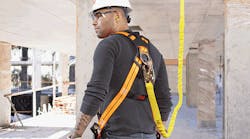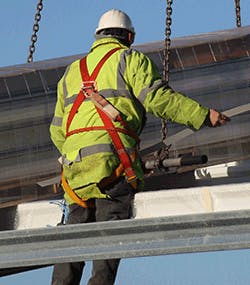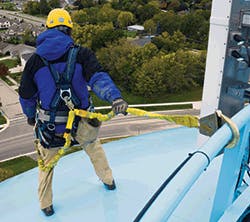The Top 5 Most-Commonly Asked Questions about Fall Protection
OSHA requires that fall protection be provided at elevations of four feet in general industry workplaces, five feet in shipyards, six feet in the construction industry and eight feet in longshoring operations. Could differences such as these be the reason why fall protection is the most-frequently cited OSHA violation?
This article will examine the most-common questions that come up about fall protection. By knowing the answers to these questions, safety managers can help provide the proper equipment to keep their workers safe.
1. What Harness Should I Use?
The answer varies widely, depending on factors such as the wearer's job tasks, the work environment and even if the harness will be shared among employees.
Generally, fall-protection harnesses are application-driven. There are specialty harnesses designed to meet the regulatory and task requirements in numerous environments and applications, including wind energy, tower climbing, utilities, oil and gas, mobile skywalk, hoisting and riding, iron working and electrical work. Harnesses used in welding applications, for example, feature heat-resistant fabric and webbing designed to resist charring and damage caused by weld splatter, while harnesses designed for tower climbing often are lightweight with built-in seats, aluminum hardware and rescue connections.
Environmental conditions also dictate when a specialty harness may be suitable for the job. For example, polyurethane-coated harnesses offer a way to help maintain harness cleanliness, possibly even helping extend the life of the products when used in extreme work environments such as tar roofing, oil-field work or painting.
The individual wearing the harness also plays a significant factor. Harnesses come in different sizes, but there also are universally sized harnesses with five points of adjustability. These harnesses – with two vertical straps running up the body to adjust the size, two leg buckles and a chest strap – generally fit a wider range of people both in height and weight, but not everyone. To ensure there are appropriate harnesses to fit every worker, safety managers also should have XS, XL and XXL harness available on site in addition to the universal harnesses or small, medium and large options.
When deciding which harness to purchase for more everyday use, different D-ring configurations and hardware can help ensure the harness is outfitted for the job at hand. For instance, when choosing which type of leg buckle to use on a harness, consider how many people will be sharing the harness. Over the course of a workday or a week, if there could be different workers using the same harness, grommet leg buckles would be best-suited because they are the easiest to adjust. Quick-connect buckles can be pre-adjusted, which is ideal for a single user, helping to more efficiently strap on the harness and get to work. The third type of leg buckle – commonly referred to as a pass-thru buckle – is the most economical, but the wearers also may have to spend a bit more time adjusting the strap through the buckle in order to ensure a snug fit.
When it comes to D-ring considerations, some people think that adding more configurations makes the harness applicable in more situations. But in reality, more is not always better and often can lead to confusion among wearers regarding which D-ring to connect to for their application.
A back D-ring comes standard on all fall-protection harnesses. Other D-ring configurations depend on the task at hand. For example, if a worker will be using a vertical-ladder climbing system, a front attachment point is necessary to keep them connected while climbing. When working in confined spaces, shoulder D-rings may be best suited for rescue or retrieval operations.
Once the basic features of the harness have been chosen, there are additional add-on options to increase ease of use and comfort including shoulder pads, leg pads, tool belts, support belts or loops for belts. Again, these will depend on the application and wearer preferences.
For instance, one might think that having extra padding is more comfortable, but a worker in a high-heat environment may think the padding is too hot. Safety managers and employees ideally should work together to identify the environment and application that fall protection equipment is needed for.
2. What Are the Height Requirements for Fall Protection?
OSHA outlines industry- and application-specific fall-protection height requirements.
Federal regulations require that fall protection be provided at elevations of four feet in general industry workplaces, five feet in shipyards, six feet in the construction industry, eight feet in long shoring operations, 10 feet for steel erection activities and 30 feet for deckers. In addition, if a worker can fall into or onto dangerous machines or equipment of any height (such as a vat or acid or a conveyor belt) employers must provide guardrails and toe-boards to prevent workers from falling and getting injured.
3. Should I Use an Energy-Absorbing Lanyard or a Self-Retracting Lanyard?
Similar to harnesses, choosing the right connector depends on the application and work environment. The basic rule is that people working below 17.5 feet should use a self-retracting lanyard (SRL) and those working above 17.5 feet can use an energy-absorbing lanyard or SRL. When using an energy-absorbing lanyard, the worker needs to be anchored at least 17.5 to 18 feet above the ground to ensure proper working clearances are achieved.
Generally, when above 17.5 feet, either an energy-absorbing lanyard or an SRL may be suitable. However, if mobility is a requirement, SRLs typically will present a wider range of movement while helping to minimize trip hazards as the lanyard always is pulled taut under retraction tension.
Both energy-absorbing lanyards and SRLs are available in web or cable and come in a variety of lengths. Web-style units may be best for indoor and less harsh environments, while cable-style lanyards may offer extra durability in abrasive or high-heat situations, such as roofing work and oil and gas applications.
4. How Much Does a Harness Cost?
Price points vary widely for full-body harnesses, ranging from $30 to $300 and upward, depending on the number of additional features like padding, lanyard keepers, fall indicators and plastic pull tabs on the end of the webbing for adjustability. Even more specialized harnesses, such as a model designed specifically for tower workers, may be even more expensive.
Price isn't nearly as important as meeting the federal and state standards when deciding on a harness. Both OSHA and ANSI have established fall protection performance standards for personal fall protection harnesses, depending on their use. Violating a single standard can lead to a fine of $7,000 or more (depending on the situation), far outweighing the initial harness cost.
OSHA regulations dictate that if a personal fall-arrest system is used for fall protection, it must do the following:
- Limit maximum arresting force on an employee to to 900 pounds (4 kilonewtons) when used with a body belt;
- Limit maximum arresting force on an employee to 1,800 pounds (8 kilonew-tons) when used with a body harness;
- Be rigged so that an employee can neither free fall more than 6 feet (1.8 meters) nor contact any lower level;
- Bring an employee to a complete stop and limit maximum deceleration distance an employee travels to 3.5 feet (1.07 meters); and
- Have sufficient strength to withstand twice the potential impact energy of an employee free falling a distance of 6 feet (1.8 meters) or the free-fall distance permitted by the system, whichever is less.
By identifying and selecting the appropriate harness and accessories to meet the task and environment requirements, employers and safety managers can help to better protect themselves and lives of their workers.
5. What is the life expectancy of fall-protection equipment?
Most fall-protection products no longer incorporate a mandatory expiration date. However, this entirely is up to the individual fall-protection equipment manufacturer. Today, there are some fall-protection products manufactured incorporating expiration dates, but most likely, the products only will identify a recommended inspection requirement. Ideally, the user should evaluate product options and inspection values that are best-suited for their application and work environment.
One important thing to note is that no matter how new or pristine-looking a piece of equipment is, if it has experienced a fall, it must be taken out of service for repair or replacement. Full-body harnesses and energy-absorbing lanyards exposed to a fall arrest immediately should be removed from service and replaced.
Some mechanical components of a fall arrest system may be repaired. For example, many SRLs can be serviced or repaired, but that can vary from product-to-product and manufacturer-to-manufacturer.
The five-year expiration rule initially was put in place as a requirement under ANSI/ASSE A10.32. However, the standard was revised in 2012 and the "five-year" guidance was removed. Fall-protection equipment produced to the revised standard no longer has a mandated retirement date. Product-service life instead should be determined though regular equipment inspections and adherence to the manufacturer's instructions.
Additionally, an annual, documented inspection should be performed by a trained, competent employee. The equipment should pass the criteria set forth by the manufacturer and user instruction manual provided with the equipment at time of shipment.
Regular inspections of your fall protection equipment, along with appropriate cleaning and storage, greatly will help prolong the life of the equipment.
Choosing the right fall protection can be a daunting task. Since falls consistently are one of the most-cited OSHA violations, it is important to take the time to assess the application, environmental conditions and each worker to help gear up with the right fall-protection equipment.
Trevor Taylor is a fall protection specialist with 3M.


